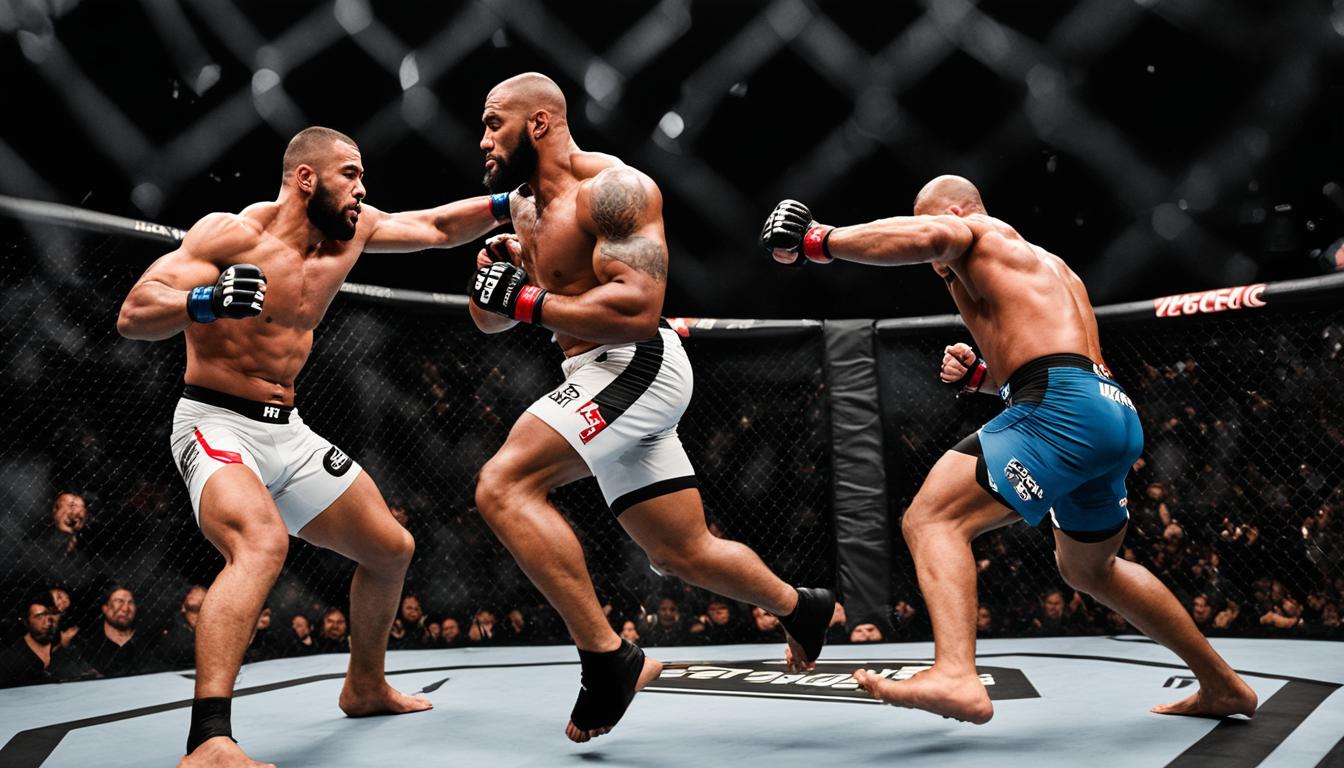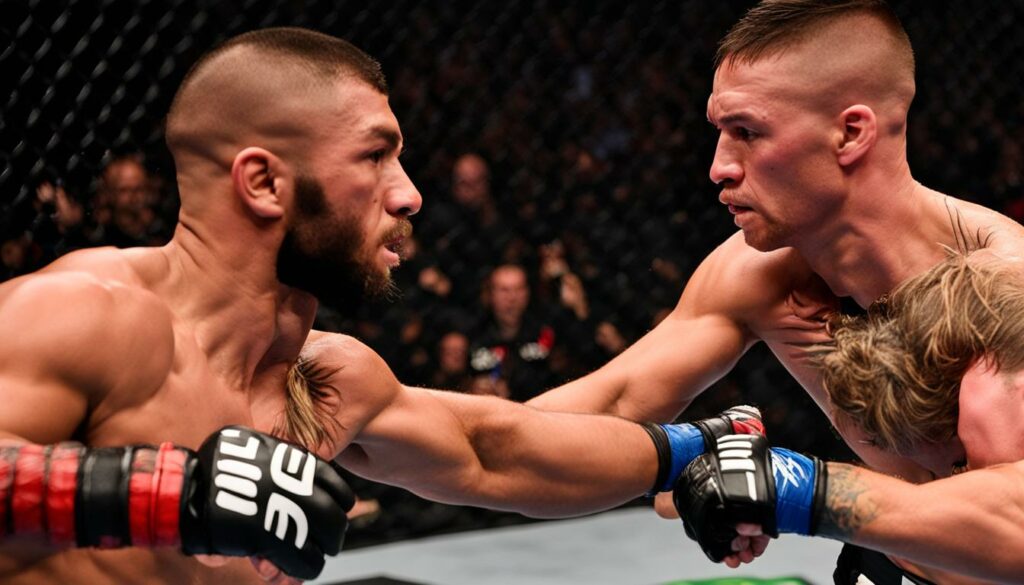The UFC has 12 weight classes, offering fighters a range of options to compete within their respective divisions. However, there are instances when fighters engage in catchweight fights, which are non-standard bouts held at a weight that is not specific to any division. These catchweight fights are typically selected to address issues such as avoiding extreme weight cutting or accommodating fighters who fail to make weight during the official weigh-in process.
During UFC weigh-ins, which take place the day before a fight, athletes are required to weigh in between 9am and 11am local time. In non-title fights, fighters are permitted to weigh one pound above the upper limit of their weight class. For title fights, athletes must either match or weigh under the specific weight set for the division. If a fighter fails to meet the weight requirement, they may be subject to penalties such as forfeiting a percentage of their fight purse to their opponent.
While catchweight fights do not count towards the UFC ranking system, they present unique match-ups that can add intrigue to the sport. These bouts may occur when fighters miss weight, or they can be scheduled in advance to avoid drastic weight cuts and promote fighter safety. The UFC has specific rules and regulations in place regarding catchweight fights, ensuring fairness and minimizing any potential disadvantages for the fighters involved.
Let’s explore the dynamics of catchweight bouts in the UFC, the rules surrounding these non-standard fights, and the significance they hold within the world of mixed martial arts.
Key Takeaways:
- Catchweight fights in the UFC are non-standard bouts held at a weight that is not specific to any division.
- These fights are usually chosen to address issues such as avoiding extreme weight cutting or accommodating fighters who fail to make weight.
- In non-title fights, fighters can weigh one pound above the upper limit of their weight class, while title fights require athletes to either match or weigh under the specific weight set for the division.
- Catchweight bouts do not count towards the UFC ranking system, but they offer unique match-ups that add excitement to the sport.
- The UFC has specific rules and regulations in place regarding catchweight fights to ensure fairness and compensate fighters for any weight discrepancies.
Catchweight Bouts: Unique Match-ups
Catchweight bouts in the UFC provide unique match-ups as fighters compete at a weight that is not specific to any division. These bouts often happen when one or both fighters miss weight during the official weigh-in. Instead of canceling the fight, the fighters may agree to compete at a catchweight.
Catchweight bouts can also be scheduled in advance if the fighters want to avoid extreme weight cutting. It’s important to note that catchweight bouts do not count towards the UFC ranking system.
Some notable catchweight fights in UFC history include Stephen Thompson vs. Darren Till at UFC Liverpool and Renan Barao vs. Aljamain Sterling at UFC 214.
Notable Catchweight Fights in UFC History
Throughout UFC history, there have been several memorable catchweight fights that have showcased the flexibility and adaptability of fighters. One such fight was the match-up between Stephen Thompson and Darren Till at UFC Liverpool. Till failed to cut weight, but both fighters agreed to compete at a catchweight, providing fans with an exciting showdown.
“Catchweight bouts allow fighters to showcase their skills without the strict limitations of weight classes, leading to intriguing match-ups that may not have happened otherwise.”
– Dana White, UFC President
Another example is the catchweight bout between Renan Barao and Aljamain Sterling at UFC 214. Barao faced difficulties cutting weight, and the California State Athletic Commission allowed the fight to take place at a catchweight of 140 pounds, giving the fighters an opportunity to showcase their abilities.
Catchweight bouts add excitement to the UFC and highlight the willingness of fighters to compete at different weights, creating memorable moments in the sport’s history.
UFC Catchweight Rules and Regulations
In order to maintain fairness and ensure proper weight management, the UFC has established specific rules and regulations for catchweight fights. These rules apply when fighters fail to make weight or when catchweight bouts are agreed upon in advance.
In non-title fights, a fighter is not allowed to weigh more than one pound over the limit for their respective weight class. This ensures that fighters do not gain an excessive advantage by carrying extra weight into the bout.
For title fights, the weight limit for catchweight bouts is even stricter. Fighters cannot exceed a weight limit that is half a pound over the division’s specific weight. This is in place to ensure that title fights adhere to the highest standards of fairness and maintain the integrity of the respective weight classes.
Catchweight bouts can be agreed upon by both fighters ahead of the bout or determined by a Sports Commission for safety concerns. This allows for flexibility in creating unique and competitive match-ups while prioritizing the well-being of the fighters involved.
It is worth noting that in catchweight fights, the fighters involved often receive a percentage of their opponent’s purse as compensation for the weight discrepancy. This serves as a way to address the challenges faced by fighters who agree to compete at non-standard weights and ensures that they are adequately rewarded for their participation.
Fighters and Catchweight Bouts Example:
“I believe catchweight bouts are beneficial for fighters who face challenges in cutting weight. It allows us to compete at a weight that we are comfortable with, without compromising our health. The UFC’s catchweight rules provide a fair framework and protect the integrity of the sport.” – Amanda Nunes, UFC Women’s Bantamweight and Featherweight Champion
| Fighter | Weight Class | Agreed Catchweight | Event |
|---|---|---|---|
| Anderson Silva | Middleweight | 192.5 lbs | UFC 101 |
| Conor McGregor | Featherweight | 170 lbs | UFC 196 |
| Nate Diaz | Lightweight | 170 lbs | UFC 196 |
Explaining MMA Weigh-ins and Rehydration Clauses
Weigh-ins are a crucial aspect of MMA, including the UFC. Fighters must meet the weight limit for their specific weight class or go slightly below it. Weigh-ins usually take place on the morning of the day before the fight, providing fighters with approximately 24 hours to rehydrate before the event.
In non-title fights, fighters are not allowed to weigh more than one pound over the limit for their weight class. However, in title fights, the weight limit is even stricter, allowing fighters to weigh no more than half a pound over the specific weight for their division. These weight limits ensure fair competition and maintain the integrity of the different weight classes in the UFC.
Recognizing the dangers of extreme weight cutting, rehydration clauses have been introduced in MMA. These clauses allow fighters to rehydrate after making weight, with doctors closely monitoring their hydration status on fight day. If a fighter is still dehydrated, doctors have the authority to withdraw them from the fight, prioritizing their safety and well-being.
| Weight Class | Non-Title Fight Weight Limit | Title Fight Weight Limit |
|---|---|---|
| Flyweight | 126 lbs | 125.5 lbs |
| Bantamweight | 136 lbs | 135.5 lbs |
| Featherweight | 146 lbs | 145.5 lbs |
| Lightweight | 156 lbs | 155.5 lbs |
| Welterweight | 166 lbs | 170.5 lbs |
| Middleweight | 186 lbs | 185.5 lbs |
| Light Heavyweight | 206 lbs | 205.5 lbs |
| Heavyweight | 266 lbs | 265.5 lbs |
Quotes:
“Weigh-ins play a crucial role in ensuring fair competition and maintaining the integrity of the different weight classes in MMA.” – MMA Insider
“Rehydration clauses have been introduced to protect fighters’ health and minimize the risks associated with extreme weight cutting.” – Sports Medicine Expert
The Dynamics of Weight Classes in UFC
The UFC currently offers fighters the opportunity to compete within 12 weight classes, each with its own specific weight range. This ensures that fighters are pitted against opponents of similar size and physical attributes, promoting fair and competitive matchups.
Within these weight classes, fighters must weigh in under the desired limit during official weigh-ins. Failure to make weight can result in penalties, such as a percentage of the fighter’s purse going to their opponent. This not only incentivizes fighters to meet their weight requirements but also maintains the integrity of each division.
Weight limits vary between divisions in the UFC, ranging from the strawweight division at 115 pounds to the heavyweight division, which allows athletes to weigh in up to 266 pounds for non-title bouts. This provides a range of weight options and allows fighters to compete at a weight appropriate for their size and fighting style.
Notable Catchweight Fights in UFC History
Throughout UFC history, there have been several notable catchweight fights that have captured the attention of fans. One example is the catchweight bout between Stephen Thompson and Darren Till at UFC Liverpool. Till failed to cut weight, but both fighters agreed to compete at a catchweight, with Thompson receiving a percentage of Till’s purse. Another memorable catchweight fight is the one between Renan Barao and Aljamain Sterling at UFC 214. Barao had difficulties cutting weight, and the California State Athletic Commission allowed the bout to take place at a catchweight of 140 pounds. These fights highlight the flexibility and adaptability of the UFC in accommodating weight discrepancies.
The Importance of Catchweight Divisions in MMA
Catchweight divisions play a crucial role in MMA, providing fighters with the opportunity to compete outside the constraints of traditional weight classes. These divisions enable unique match-ups and help mitigate the risks associated with extreme weight cutting, which can have detrimental effects on fighters’ health.
By allowing bouts at catchweight, the sport promotes adaptability and versatility among its athletes. Fighters who are willing to compete at different weights demonstrate their ability to adjust their strategies and tactics accordingly, showcasing their skills across a broader range of weight categories.
Furthermore, catchweight divisions emphasize the significance of weight management in MMA. In order to compete effectively, fighters must carefully monitor and control their weight to stay within their desired range. This presents an additional challenge as they strive to optimize their performance while ensuring they are physically prepared for their chosen weight class.
Overall, catchweight divisions bring excitement and diversity to the MMA landscape. They enable extraordinary matchups that transcend traditional weight classes, showcasing the adaptability and versatility of fighters. The importance of weight management and the challenges associated with it are highlighted, illustrating the dedication and discipline required to succeed in the sport.
Conclusion
Catchweight bouts in the UFC provide fighters with the flexibility to compete at a weight that best suits them, outside of the standard weight classes. These non-standard bouts offer unique match-ups and help prevent the risks associated with extreme weight cutting. While catchweight fights do not contribute to the UFC ranking system, they bring excitement and showcase the adaptability of fighters in the ever-evolving world of mixed martial arts.
The rules and regulations surrounding catchweight bouts ensure fair competition, with fighters compensated for any weight discrepancies. Catchweight divisions play a vital role in the sport, allowing fighters to showcase their skills without the strict limitations imposed by weight classes. These divisions demonstrate the importance of weight management and the challenges that fighters face in maintaining their desired weight.
Overall, catchweight bouts add an element of unpredictability to the UFC, with fighters willing to test their skills at different weights. As the sport continues to evolve, catchweight match-ups will remain an intriguing aspect of MMA, captivating fans and illustrating the versatility and determination of fighters.


